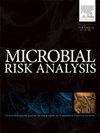Quantitative microbiological risk assessment using individual data on food storage and consumption (Part 2): A comparison with traditional QMRA approaches
IF 4
4区 环境科学与生态学
Q2 ENVIRONMENTAL SCIENCES
引用次数: 0
Abstract
In a previous study, we integrated data from individual consumers collected in a dietary survey in France in a multi-food quantitative microbiological risk assessment (QMRA) for listeriosis. Here, we compared the “individual-based” modelling approach applied in that study with several other approaches where the data are treated as in more “traditional” QMRA methods, for example by assuming independent randomly sampled variables from distributions fitted through the data, instead of the observed individual data themselves. We found that assigning randomly sampled storage times instead of the reported individual storage times resulted in a higher risk estimate than the baseline, expressed as expected annual number of cases in the population. Assigning randomly sampled storage temperature and point estimates for portion size and frequency of consumption, slightly increased the estimated risk. Statistical analysis did not show dependency between portion size, frequency of consumption, storage temperature and storage time in the data set, which can be explained by the fact that only a few individuals had a large impact on the final population risk. Analysis of expected numbers of cases per age class, sex and food group showed small differences between approaches. Our analysis was challenged by the difference between a model structure where the risk is calculated per individual (when based on a dietary survey with individual data) and one where it is calculated per serving, as in “traditional” QMRA. We showed that an “individual-based” QMRA is more resource-demanding but can give fundamentally different risk estimates, which are potentially more accurate. The application of tools for efficient knowledge exchange and integration is needed to facilitate the usage of this type of QMRA.
使用食品储存和消费的个人数据进行定量微生物风险评估(第2部分):与传统QMRA方法的比较
在之前的一项研究中,我们将从法国膳食调查中收集的个人消费者数据整合到李斯特菌病的多种食品定量微生物风险评估(QMRA)中。在这里,我们将该研究中应用的“基于个体”的建模方法与其他几种方法进行了比较,这些方法将数据视为更“传统”的QMRA方法,例如,通过假设来自数据拟合分布的独立随机抽样变量,而不是观察到的个体数据本身。我们发现,分配随机抽样的储存时间,而不是报告的个人储存时间,导致比基线更高的风险估计,以预期的人口年病例数表示。分配随机采样的存储温度和对部分大小和消费频率的点估计,稍微增加了估计的风险。统计分析显示,数据集中的分量大小、食用频率、储存温度和储存时间之间没有相关性,这可以解释为只有少数个体对最终群体风险有很大影响。对每个年龄段、性别和食物组的预期病例数的分析显示,不同方法之间的差异很小。我们的分析受到了模型结构差异的挑战,模型结构中风险是按个人计算的(基于个人数据的饮食调查),而模型结构中风险是按每份食物计算的(如“传统”QMRA)。我们表明,“基于个人的”QMRA需要更多的资源,但可以给出根本不同的风险估计,这可能更准确。为了促进这类QMRA的使用,需要应用有效的知识交换和集成工具。
本文章由计算机程序翻译,如有差异,请以英文原文为准。
求助全文
约1分钟内获得全文
求助全文
来源期刊

Microbial Risk Analysis
Medicine-Microbiology (medical)
CiteScore
5.70
自引率
7.10%
发文量
28
审稿时长
52 days
期刊介绍:
The journal Microbial Risk Analysis accepts articles dealing with the study of risk analysis applied to microbial hazards. Manuscripts should at least cover any of the components of risk assessment (risk characterization, exposure assessment, etc.), risk management and/or risk communication in any microbiology field (clinical, environmental, food, veterinary, etc.). This journal also accepts article dealing with predictive microbiology, quantitative microbial ecology, mathematical modeling, risk studies applied to microbial ecology, quantitative microbiology for epidemiological studies, statistical methods applied to microbiology, and laws and regulatory policies aimed at lessening the risk of microbial hazards. Work focusing on risk studies of viruses, parasites, microbial toxins, antimicrobial resistant organisms, genetically modified organisms (GMOs), and recombinant DNA products are also acceptable.
 求助内容:
求助内容: 应助结果提醒方式:
应助结果提醒方式:


